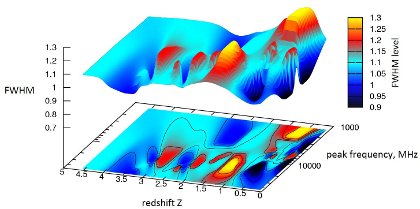

|
Study of radio spectra and variability of GPS sources |
Russian version |
|
The results of long-term monitoring of Gigahertz-Peaked Spectrum sources
were found the statistically significant differences (0.05 significance
level) in the high-frequency spectral index distribution between subgroups
of galaxies and quasars. For galaxies the average spectral index of the
optically thin part is equal to -0.93 (0.07), which is considerably
less than for quasars -0.70 (0.04); the difference is about 0.23.
This can mean that the electron energy distribution for GPS galaxies
is steeper than for GPS quasars.
In this distribution the mean value of γ index of electron
energy spectrum dN(E)=kE-γdE is 0.46 larger for galaxies
(i.e. their energy spectra are steeper) than for quasars. Within the
framework of a common model of GPS sources, this fact can be interpreted
in the following ways: a) the observed sample of galaxies (their proper age)
is older than the quasar sample (the proper age of quasars); the steepening
of their energy spectra is related to additional (in comparison to quasars)
age losses of energy for radiation [Kardashev 1962]; b) the proper ages of
quasar and galaxy samples are approximately identical, but the observed
difference in γ is related to the fact that the galaxies in the
observed sample were born later than quasars at small red shift z, i.e.
there is a cosmological difference in electron energy spectra.
|

Fig.1. The relation "redshift-peak frequency-FWHM" for sources with FWHM≤1.3. The limit of value 1.3 corresponds to sources with inexact convex spectra shape (undetermined spectral shape due to uncertain flux densities or limited frequency range). |